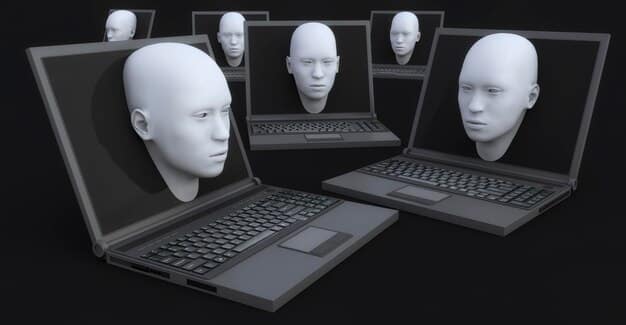Ethical Implications of AI Surveillance in the US: A Deep Dive

AI-powered surveillance in the US raises ethical concerns regarding privacy violations, bias amplification, and potential for misuse, demanding careful consideration and regulation.
The rise of AI-powered surveillance technologies in the United States presents a complex web of ethical dilemmas. Understanding What are the Ethical Implications of AI-Powered Surveillance in the US? is crucial for safeguarding individual rights and shaping responsible innovation.
Understanding AI-Powered Surveillance
AI-powered surveillance goes beyond traditional security cameras. It involves using artificial intelligence to analyze vast amounts of data collected from various sources, such as video feeds, social media posts, and online activity. This technology can identify patterns, predict behaviors, and track individuals, raising serious ethical questions about privacy and civil liberties.
How AI Enhances Surveillance
AI algorithms can process data far more efficiently than humans, enabling real-time analysis and predictive capabilities. This enhancement, however, amplifies the potential for misuse and discriminatory practices.
- Automated Facial Recognition: Identifying individuals from video footage with high accuracy.
- Predictive Policing: Using data to forecast where crimes are likely to occur.
- Social Media Monitoring: Analyzing online activity to identify potential threats or dissent.
The scale and sophistication of AI-powered surveillance demand a thorough examination of its ethical implications to ensure fairness, transparency, and accountability.

AI-powered surveillance represents a significant technological advancement, but its deployment must be guided by strong ethical principles and legal frameworks.
Privacy Concerns and Data Collection
One of the primary ethical concerns surrounding AI-powered surveillance is the erosion of privacy. Mass data collection, often without explicit consent, raises questions about how this information is stored, used, and protected.
The Scope of Data Collection
Surveillance systems collect a wide range of personal data, including biometric information, location data, and online behavior. This data can be used to create detailed profiles of individuals, potentially leading to discrimination and unfair treatment.
- Lack of Transparency: Individuals are often unaware of the extent to which they are being monitored.
- Data Security Risks: Collected data is vulnerable to breaches and unauthorized access.
- Potential for Function Creep: Data collected for one purpose may be used for unrelated purposes without consent.
Robust privacy regulations and transparent data governance practices are essential to mitigate these risks and protect individual rights.
The balance between security and privacy must be carefully considered to prevent the creation of a surveillance state.
Bias and Discrimination in AI Surveillance
AI algorithms are trained on data, and if that data reflects existing biases, the algorithms will perpetuate and even amplify those biases. This can lead to discriminatory outcomes in surveillance applications, particularly for marginalized communities.

Examples of AI Bias in Surveillance
Studies have shown that facial recognition systems are less accurate in identifying people of color, leading to wrongful arrests and disproportionate targeting by law enforcement. Predictive policing algorithms can also reinforce existing patterns of racial bias in crime statistics.
- Unequal Treatment: Biased algorithms can lead to unfair targeting of certain groups.
- Lack of Fairness: Algorithmic decisions can perpetuate systemic inequalities.
- Erosion of Trust: Biased systems can undermine public trust in law enforcement and technology.
Addressing bias in AI surveillance requires diverse datasets, rigorous testing, and ongoing monitoring to ensure fairness and accuracy.
Fairness and accountability are paramount when deploying AI surveillance systems to avoid perpetuating discrimination.
Accountability and Oversight Mechanisms
Establishing clear lines of accountability and effective oversight mechanisms is crucial to prevent the misuse of AI-powered surveillance. This includes defining who is responsible for the system’s operation, how it is monitored, and what recourse is available to individuals who are harmed.
The Need for Transparency and Regulation
Transparency in the design and deployment of AI surveillance systems is essential for public trust. Regulations should require disclosure of how these systems work, what data they collect, and how they are used.
The absence of transparency is also a major concern. It can lead to a lack of accountability when errors occur or when the AI system produces biased outcomes. Here are some more issues regarding oversight:
- Independent Audits: Regular audits can help identify and address biases and inaccuracies.
- Legal Frameworks: Laws should define the permissible uses of AI surveillance and protect individual rights.
- Public Engagement: Involving the public in discussions about surveillance policies can promote accountability.
Strong accountability and oversight mechanisms are necessary to ensure that AI surveillance systems are used responsibly and ethically.
Without clear accountability, the potential for abuse and misuse of AI surveillance technologies increases significantly.
Balancing Security and Liberty
Finding the right balance between security and liberty is a central challenge in the age of AI-powered surveillance. While these technologies can enhance public safety, they also pose a significant threat to individual freedoms and democratic values.
Defining Acceptable Uses of AI Surveillance
It is essential to have a public conversation about the types of surveillance that are acceptable in a democratic society. This includes defining the circumstances under which surveillance can be used, the types of data that can be collected, and the safeguards that must be in place to protect individual rights.
There are different ways in which AI is being adopted, here are 3 of them:
- Proportionality: Surveillance should be proportionate to the threat it is intended to address.
- Necessity: Surveillance should only be used when it is necessary and there are no less intrusive alternatives.
- Purpose Limitation: Data collected through surveillance should only be used for the specific purpose for which it was collected.
Careful consideration must be given to the potential impacts of AI surveillance on freedom of speech, assembly, and association.
Safeguarding civil liberties requires a continuous balancing act between security and freedom.
Future Trends and Potential Risks
As AI technology continues to advance, the capabilities of surveillance systems will only become more sophisticated. This raises the stakes for ethical considerations and the need for proactive regulation.
Emerging Technologies and Concerns
Developments in areas such as emotion recognition, deepfakes, and biometric tracking could further blur the lines between surveillance and control. It is essential to anticipate these trends and address the ethical implications before they become widespread.
The advent of sophisticated AI is causing concern. In particular, the growing sophistication is due to:
- Emotion Recognition: Analyzing facial expressions and vocal tones to infer emotional states.
- Deepfakes: Creating realistic but fake videos and audio recordings.
- Biometric Tracking: Monitoring individuals based on unique biological characteristics.
The future of AI surveillance demands vigilance and a commitment to protecting human rights.
Staying ahead of technological advancements is crucial for addressing the evolving ethical challenges of AI surveillance.
International Perspectives on AI Surveillance
AI-powered surveillance isn’t just in the US. Different countries have different approaches, laws and opinions surrounding its ethical and practical implications. Understanding these can provide valuable context and insights for the United States.
### Global Approaches to AI Surveillance Ethics
Some nations focus on stringent data protection and privacy rights, whereas others prioritize national security and public safety, leading to different regulations.
* **European Union:** The EU’s General Data Protection Regulation (GDPR) sets a high standard for data protection, creating a privacy-focused framework that affects AI-powered surveillance.
* **China:** China has extensively implemented AI-powered surveillance for social monitoring and security, raising human rights and personal freedom issues.
* **Canada:** Canada aims to strike a balance between privacy protection and security through laws like the Personal Information Protection and Electronic Documents Act (PIPEDA).
Examining these international perspectives helps the US refine its approach to AI surveillance, incorporating best practices while considering its own unique context and values.
Learning from global experiences is essential for informing the governance and deployment of AI surveillance technologies.
| Key Aspect | Brief Description |
|---|---|
| 🛡️ Privacy Concerns | Mass data collection and its potential misuse. |
| ⚖️ Bias & Discrimination | AI algorithms amplifying existing societal biases. |
| 🤝 Accountability | Need for clear oversight and responsibility. |
| 🌐 Global Perspectives | Different countries have different rules and approaches regarding AI. |
Frequently Asked Questions
▼
AI-powered surveillance uses artificial intelligence to analyze data from various sources, enhance monitoring, and predict behaviors, raising concerns about privacy and civil liberties.
▼
AI is susceptible to bias when trained on data reflecting existing inequalities. These biases can perpetuate discrimination, such as inaccurate facial recognition for people of color.
▼
The privacy implications are vast due to mass data collection without explicit consent, data security risks, and potential function creep, leading to detailed profiling and unfair treatment.
▼
Essential mechanisms include clear legal frameworks, independent audits, and public engagement to ensure transparency, prevent misuse, and protect individual rights from abuse in surveillance.
▼
Balancing these involves defining acceptable uses, ensuring proportionality and necessity in surveillance, and limiting data use to its intended purpose, safeguarding civil liberties.
Conclusion
The ethical implications of AI-powered surveillance in the US are profound and multifaceted. Addressing these challenges requires a combination of robust regulations, transparency in data practices, and a commitment to fairness and accountability. By carefully considering these issues, we can harness the benefits of AI while protecting fundamental rights and democratic values.





